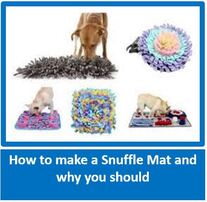
Have your dog associate 'good' things with the baby, have a look at all our top quality toys that can be stuffed, and given as a special treat when mom is busy with baby, or food puzzle toys to stimulate. Also consider a cosy dog bed for Fido to lie on instead of the couches - this prevents many resource guarding concerns. We also have just about everything else you could want for your dogs, cats and of course the small critters. www.mcmac.co.za
The Facts & Myths about Dogs and Babies
www.dogstodiapers.com - has a Blog with lots of tips for dogs and babies - enjoy!
www.dogstodiapers.com - has a Blog with lots of tips for dogs and babies - enjoy!

MYTH NUMBER 1: - Your dog will accept your new baby into the family and there is no need to train them; they will accept/love the baby because you do. For generations we have introduced dogs and have left it to the chance for the dog to accept the baby and all that comes along with the developing stages from new-born to toddler, to child.
FACT - No family wants to believe that their dog is capable of biting or mauling their child. According to Fatal Dog Attack Statistics, the age groups with the highest number of fatalities are children under the age of 1 year old, and this age group accounts for 19% of the deaths due to dog attacks. Of these, 72% were less than 90 days old. In addition, the Atlanta Study and multiple other studies have found that children were bitten by family dogs or dogs known to the family in up to 85% of the cases.
The majority of these deaths occur to new-borns within the first 90 days of bringing them home and statistics have shown most of the attacks occur when the baby is asleep in a crib or bassinet.
You are asking yourself how this could be and the answer is simple: Dogs are predatory animals that react off of instinct and, if your dog is pre-dispositioned genetically to have a high prey drive, then the dog can perceive your new-born baby as prey. Everything down to how your newborn baby cries could trigger a response in your dog that could result in them “attacking the prey.” As a trainer and mom, I must emphasize that predatory behavior in dogs is REAL. We need to be aware of all this information about our dogs before bringing home your new-born. There is a precautionary test that can help us to understand the characteristics of our dog and how they might respond to the new baby.
Another thing to note is that up to this point your dog has never had to share their territory with anything. There is a level of competition and threat that can go along with bringing home a new baby. Your dog now sees that all your attention is on that baby and some dogs have trouble adjusting to this especially if they are used to controlling the household and getting all the attention.
MYTH NUMBER 2 - Your dog will be good around your newborn because they have been around kids before and loved them.
FACT - We live in a culture that waits until there is a problem before deciding we need to take action.
As a dog trainer, this is a recipe for disaster especially when it involves dogs and babies.
In the majority of families, I meet they have their dog first before their baby arrives, and the dog is pretty much their “Fur Baby”! I have attended numerous Prego Expos and I always ask expecting moms “Is your dog ready for the arrival of your newborn?” and they tell me “Yes! My dog has been around kids and loves them” or “My dog can tell something is different about me.” From these statements, I know that they have NO CLUE what is about to transpire in their dog’s routine and life.
When somebody compares how their dog acts around kids, that is significantly different then how your dog will behave when there is a crying, smelly, noisy, crawling, all attention-getting little baby that is never leaving! We are barely ready for that as parents let alone the dogs!
We need to use caution when using the term “kid friendly” too loosely. A dog that has been raised around babies and kids is very different than a dog that has been exposed to them for short amounts of time.
MYTH NUMBER 3 - Using a “fake” baby will help your dog prepare for your newborn and will give us an idea of how the dog will respond to the new baby.
FACT - We have no way of knowing how your dog will perceive the “fake” baby and dogs are extremely intelligent creatures. If for months you are preparing your dog with a “fake” baby and then your new-born arrives that moves, makes noise, and has a new smell it could actually draw more suspicion and curiosity to your dog. We also never want our dog to think the newborn baby is a toy. I have seen many families prepare the dog with this “fake” baby only to leave it laying around on the counter!
(Note from FOTD - what is important is to try to obtain one of the wonderful doll baby toys that actually look like a real baby and even make noises. If you have a friend with a baby you can ask them to use a baby grower you donate on their own baby, and then you dress the doll in this prior to the introduction and for a few days. Use baby powder and carry and interact with the doll as you would with a real baby. If the dog shows fear, nervous or reactive behaviour on first meeting the doll, get professional help.
MYTH NUMBER. 4 - When your dog nips at the baby, that is OK because the child needs to learn not to roughhouse with the dog.
FACT - We live in a culture that waits until there is a problem before deciding we need to take action.
As a dog trainer, this is a recipe for disaster especially when it involves dogs and babies.
In the majority of families, I meet they have their dog first before their baby arrives, and the dog is pretty much their “Fur Baby”! I have attended numerous Prego Expos and I always ask expecting moms “Is your dog ready for the arrival of your new-born?” and they tell me “Yes! My dog has been around kids and loves them” or “My dog can tell something is different about me.” From these statements, I know that they have NO CLUE what is about to transpire in their dog’s routine and life.
When somebody compares how their dog acts around kids, that is significantly different then how your dog will behave when there is a crying, smelly, noisy, crawling, all attention-getting little baby that is never leaving! We are barely ready for that as parents let alone the dogs!
We need to use caution when using the term “kid friendly” too loosely. A dog that has been raised around babies and kids is very different than a dog that has been exposed to them for short amounts of time.
MYTH NUMBER 5 - Pit Bulls are famous for being the “nanny dog”.
Here is an exert from an interview that we did with Leri Hanson, a pit bull breeder.
Carrie: Do you support the nickname that Pit Bulls are “Nanny Dogs?”
Leri: I used to. That whole nanny dog movement was very pretty and really nice, and we could use it as a good rebuttal until the bad things the Pit Bulls were doing. But my sources say there is nothing to prove that they were ever a nanny dog, though there are old pictures of Pit Bulls and kids. Now, what I do agree with is that they have such a high tolerance for pain that when a kid is pulling on their ears, tail, or lip that they are okay with that. And I don’t think we should let kids do that, but these dogs are not as reactive as your average dog. I think that is where that whole “nanny dog” phrase came up. I thought the same thing originally, although I’ll tell you that I’m much more comfortable with my grandkids around the Pit Bull dogs than some of my other breeds. Now that I am a little bit more aware of dog behavior in general than I was when I was raising my kids, I wouldn’t allow that level of interaction anymore.
MYTH NUMBER 6 - Letting the dog sleep with your kid will make them bond together.
FACT - Allowing your dog to sleep with your kids puts them all on equal playing ground. They might as well be littermates. Some dogs can be up on furniture and in beds with no problems while other dogs can get territorial over their space. This is very dependent on that individual dog but putting your child in a situation where the dog could growl/nip if rolled on or if the child gets up to use the bathroom and then comes back to the dog not wanting to move over could be dangerous. The dog should have their own sleeping space on a dog bed on the floor.
MYTH No. 7 - My dog is so well tempered he will allow my kids to grab his/her food while eating.
FACT - As a dog trainer, I hear this all the time. When did that become the determining factor on if your dog and child would be OK together? It’s important to remember that food and water are resources for a dog. If there is an abundant resource, the dog might be less likely to guard it. But that is also dependent on the dogs drive for it. Some dogs have a higher food drive and will feel like they are in competition to eat or guard their food. Even in a pack of puppies, if the food gets low, the puppies will challenge each other until its all gone. I have seen a 12-week old puppy fight over a bone and even guard a toy from me when I was going to take it. I am a firm believer that our dogs should be allowed their space to eat and drink without stress. Just because your dog allows your child to play with their food doesn’t mean they won’t ever guard their resource or nip. It just means at the moment they are being very tolerant of the situation and it may be just out of respect that you are there.
MYTH NUMBER 8 - I trust my dog alone with my baby.
FACT - Dogs are animals and animals can be unpredictable. This statement sets all parties up for failure. Everybody needs to respect the breed of dog you have and understand the characteristics of that breed. There is nothing to prove in this area especially when it comes to the safety of your child or their friends. It is not enough to say that children and dogs should never be left alone unsupervised. Even that statement gives a false sense that if you are in the room that nothing would happen. The truth is you need to know and understand your individual dog and manage your household accordingly.
MYTH NUMBER 9
My dog has been around kids and never had an issue, so this information doesn’t pertain to me bringing home a new-born.
FACT - A kid and a new-born/baby are not the same context for your dog and they may not treat them the same. Your dog might not know what the sounds and movements of a new-born are. Sometimes a dog can have impulse issues around a baby’s high pitch scream and irregular movements. A predatory response could be triggered within your dog and that could be dangerous to your new-born.
*According to fatal dog attacks statistics, the age group with the highest number of fatalities our children under the age of one year old and account for 19% of the deaths due to dog attacks.
*Of these, 72% of deaths were new-borns less than 90 days old.
Remember, your dog may not understand your new-born is a human. There are ways you can test your dog and help you to know the best training approaches to take and how to work with them for the safety of your new baby.
MYTH NUMBER 10 - There are only certain breeds that you need to worry about around babies or Young Kids.
FACT - Any breed of dog is capable of nipping/biting/mauling or killing a child. It is important to understand that certain breeds have different bite styles and as a result can cause more damage if they do bite especially when a young child is involved. You have to know your dogs breed characteristics to help you know what their bite style is. A herding dog such as an Australian Shepherd was bred to herd. Therefore their bite style is to nip and they can tend to bite at kids legs when they run. A Pit Bull has a fight drive and their style of biting is to hold on and thrash. Jack Russell’s were bred to hunt vermin and they also will tend to hold on to their prey. Any bite can cause damage and also a dog that normal would bite and pull or maybe nip could also be capable of other styles depending on the response they are getting while on the bite.
MYTH NUMBER 11 - Once a dog bites or tastes blood it will always be aggressive and you need to get rid of the dog.
FACT - Once a dog resorts to biting, it has now opened up a new behavior and depending on the result that came after the bite determines if the behavior was successful or not. If the dog is fearful and biting resulted in the “threat” backing away from them then to the dog, it worked. If in the same scenario, the “threat” kept coming and then the dog backed away, then biting had no effect. A dog is going to do what gets the results they are looking for. That is why a lot of dogs growl when threatened because it is a warning signal. If growling never works, the next action could be biting. If the dog has no outlet or place to get away, sometimes they feel biting is the only option. It is very rare for a dog to bite with no reason or precursor. In cases where they do, it is normally a predatory bite and then yes in those cases it could be unpredictable keeping that dog if you can’t manage them appropriately, especially around kids.
FACT - No family wants to believe that their dog is capable of biting or mauling their child. According to Fatal Dog Attack Statistics, the age groups with the highest number of fatalities are children under the age of 1 year old, and this age group accounts for 19% of the deaths due to dog attacks. Of these, 72% were less than 90 days old. In addition, the Atlanta Study and multiple other studies have found that children were bitten by family dogs or dogs known to the family in up to 85% of the cases.
The majority of these deaths occur to new-borns within the first 90 days of bringing them home and statistics have shown most of the attacks occur when the baby is asleep in a crib or bassinet.
You are asking yourself how this could be and the answer is simple: Dogs are predatory animals that react off of instinct and, if your dog is pre-dispositioned genetically to have a high prey drive, then the dog can perceive your new-born baby as prey. Everything down to how your newborn baby cries could trigger a response in your dog that could result in them “attacking the prey.” As a trainer and mom, I must emphasize that predatory behavior in dogs is REAL. We need to be aware of all this information about our dogs before bringing home your new-born. There is a precautionary test that can help us to understand the characteristics of our dog and how they might respond to the new baby.
Another thing to note is that up to this point your dog has never had to share their territory with anything. There is a level of competition and threat that can go along with bringing home a new baby. Your dog now sees that all your attention is on that baby and some dogs have trouble adjusting to this especially if they are used to controlling the household and getting all the attention.
MYTH NUMBER 2 - Your dog will be good around your newborn because they have been around kids before and loved them.
FACT - We live in a culture that waits until there is a problem before deciding we need to take action.
As a dog trainer, this is a recipe for disaster especially when it involves dogs and babies.
In the majority of families, I meet they have their dog first before their baby arrives, and the dog is pretty much their “Fur Baby”! I have attended numerous Prego Expos and I always ask expecting moms “Is your dog ready for the arrival of your newborn?” and they tell me “Yes! My dog has been around kids and loves them” or “My dog can tell something is different about me.” From these statements, I know that they have NO CLUE what is about to transpire in their dog’s routine and life.
When somebody compares how their dog acts around kids, that is significantly different then how your dog will behave when there is a crying, smelly, noisy, crawling, all attention-getting little baby that is never leaving! We are barely ready for that as parents let alone the dogs!
We need to use caution when using the term “kid friendly” too loosely. A dog that has been raised around babies and kids is very different than a dog that has been exposed to them for short amounts of time.
MYTH NUMBER 3 - Using a “fake” baby will help your dog prepare for your newborn and will give us an idea of how the dog will respond to the new baby.
FACT - We have no way of knowing how your dog will perceive the “fake” baby and dogs are extremely intelligent creatures. If for months you are preparing your dog with a “fake” baby and then your new-born arrives that moves, makes noise, and has a new smell it could actually draw more suspicion and curiosity to your dog. We also never want our dog to think the newborn baby is a toy. I have seen many families prepare the dog with this “fake” baby only to leave it laying around on the counter!
(Note from FOTD - what is important is to try to obtain one of the wonderful doll baby toys that actually look like a real baby and even make noises. If you have a friend with a baby you can ask them to use a baby grower you donate on their own baby, and then you dress the doll in this prior to the introduction and for a few days. Use baby powder and carry and interact with the doll as you would with a real baby. If the dog shows fear, nervous or reactive behaviour on first meeting the doll, get professional help.
MYTH NUMBER. 4 - When your dog nips at the baby, that is OK because the child needs to learn not to roughhouse with the dog.
FACT - We live in a culture that waits until there is a problem before deciding we need to take action.
As a dog trainer, this is a recipe for disaster especially when it involves dogs and babies.
In the majority of families, I meet they have their dog first before their baby arrives, and the dog is pretty much their “Fur Baby”! I have attended numerous Prego Expos and I always ask expecting moms “Is your dog ready for the arrival of your new-born?” and they tell me “Yes! My dog has been around kids and loves them” or “My dog can tell something is different about me.” From these statements, I know that they have NO CLUE what is about to transpire in their dog’s routine and life.
When somebody compares how their dog acts around kids, that is significantly different then how your dog will behave when there is a crying, smelly, noisy, crawling, all attention-getting little baby that is never leaving! We are barely ready for that as parents let alone the dogs!
We need to use caution when using the term “kid friendly” too loosely. A dog that has been raised around babies and kids is very different than a dog that has been exposed to them for short amounts of time.
MYTH NUMBER 5 - Pit Bulls are famous for being the “nanny dog”.
Here is an exert from an interview that we did with Leri Hanson, a pit bull breeder.
Carrie: Do you support the nickname that Pit Bulls are “Nanny Dogs?”
Leri: I used to. That whole nanny dog movement was very pretty and really nice, and we could use it as a good rebuttal until the bad things the Pit Bulls were doing. But my sources say there is nothing to prove that they were ever a nanny dog, though there are old pictures of Pit Bulls and kids. Now, what I do agree with is that they have such a high tolerance for pain that when a kid is pulling on their ears, tail, or lip that they are okay with that. And I don’t think we should let kids do that, but these dogs are not as reactive as your average dog. I think that is where that whole “nanny dog” phrase came up. I thought the same thing originally, although I’ll tell you that I’m much more comfortable with my grandkids around the Pit Bull dogs than some of my other breeds. Now that I am a little bit more aware of dog behavior in general than I was when I was raising my kids, I wouldn’t allow that level of interaction anymore.
MYTH NUMBER 6 - Letting the dog sleep with your kid will make them bond together.
FACT - Allowing your dog to sleep with your kids puts them all on equal playing ground. They might as well be littermates. Some dogs can be up on furniture and in beds with no problems while other dogs can get territorial over their space. This is very dependent on that individual dog but putting your child in a situation where the dog could growl/nip if rolled on or if the child gets up to use the bathroom and then comes back to the dog not wanting to move over could be dangerous. The dog should have their own sleeping space on a dog bed on the floor.
MYTH No. 7 - My dog is so well tempered he will allow my kids to grab his/her food while eating.
FACT - As a dog trainer, I hear this all the time. When did that become the determining factor on if your dog and child would be OK together? It’s important to remember that food and water are resources for a dog. If there is an abundant resource, the dog might be less likely to guard it. But that is also dependent on the dogs drive for it. Some dogs have a higher food drive and will feel like they are in competition to eat or guard their food. Even in a pack of puppies, if the food gets low, the puppies will challenge each other until its all gone. I have seen a 12-week old puppy fight over a bone and even guard a toy from me when I was going to take it. I am a firm believer that our dogs should be allowed their space to eat and drink without stress. Just because your dog allows your child to play with their food doesn’t mean they won’t ever guard their resource or nip. It just means at the moment they are being very tolerant of the situation and it may be just out of respect that you are there.
MYTH NUMBER 8 - I trust my dog alone with my baby.
FACT - Dogs are animals and animals can be unpredictable. This statement sets all parties up for failure. Everybody needs to respect the breed of dog you have and understand the characteristics of that breed. There is nothing to prove in this area especially when it comes to the safety of your child or their friends. It is not enough to say that children and dogs should never be left alone unsupervised. Even that statement gives a false sense that if you are in the room that nothing would happen. The truth is you need to know and understand your individual dog and manage your household accordingly.
MYTH NUMBER 9
My dog has been around kids and never had an issue, so this information doesn’t pertain to me bringing home a new-born.
FACT - A kid and a new-born/baby are not the same context for your dog and they may not treat them the same. Your dog might not know what the sounds and movements of a new-born are. Sometimes a dog can have impulse issues around a baby’s high pitch scream and irregular movements. A predatory response could be triggered within your dog and that could be dangerous to your new-born.
*According to fatal dog attacks statistics, the age group with the highest number of fatalities our children under the age of one year old and account for 19% of the deaths due to dog attacks.
*Of these, 72% of deaths were new-borns less than 90 days old.
Remember, your dog may not understand your new-born is a human. There are ways you can test your dog and help you to know the best training approaches to take and how to work with them for the safety of your new baby.
MYTH NUMBER 10 - There are only certain breeds that you need to worry about around babies or Young Kids.
FACT - Any breed of dog is capable of nipping/biting/mauling or killing a child. It is important to understand that certain breeds have different bite styles and as a result can cause more damage if they do bite especially when a young child is involved. You have to know your dogs breed characteristics to help you know what their bite style is. A herding dog such as an Australian Shepherd was bred to herd. Therefore their bite style is to nip and they can tend to bite at kids legs when they run. A Pit Bull has a fight drive and their style of biting is to hold on and thrash. Jack Russell’s were bred to hunt vermin and they also will tend to hold on to their prey. Any bite can cause damage and also a dog that normal would bite and pull or maybe nip could also be capable of other styles depending on the response they are getting while on the bite.
MYTH NUMBER 11 - Once a dog bites or tastes blood it will always be aggressive and you need to get rid of the dog.
FACT - Once a dog resorts to biting, it has now opened up a new behavior and depending on the result that came after the bite determines if the behavior was successful or not. If the dog is fearful and biting resulted in the “threat” backing away from them then to the dog, it worked. If in the same scenario, the “threat” kept coming and then the dog backed away, then biting had no effect. A dog is going to do what gets the results they are looking for. That is why a lot of dogs growl when threatened because it is a warning signal. If growling never works, the next action could be biting. If the dog has no outlet or place to get away, sometimes they feel biting is the only option. It is very rare for a dog to bite with no reason or precursor. In cases where they do, it is normally a predatory bite and then yes in those cases it could be unpredictable keeping that dog if you can’t manage them appropriately, especially around kids.




